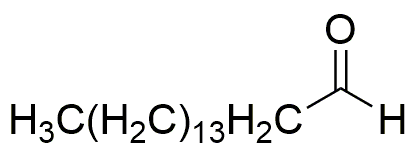Hexadecanal is widely utilized in research focused on:
- Fragrance and Flavor Industry: This compound is commonly used as a fragrance ingredient in perfumes and cosmetics, providing a pleasant, fatty odor reminiscent of natural sources like palm oil.
- Food Industry: Hexadecanal serves as a flavoring agent in food products, enhancing the sensory experience of various dishes, particularly in baked goods and confections.
- Biochemical Research: It is employed in studies related to lipid metabolism and cellular signaling, helping researchers understand the role of fatty aldehydes in biological systems.
- Cosmetic Formulations: The compound is used in skin care products for its emollient properties, helping to improve skin texture and moisture retention.
- Industrial Applications: Hexadecanal can be utilized in the production of surfactants and emulsifiers, which are essential in various industrial processes, including detergents and coatings.
General Information
Properties
Safety and Regulations
Applications
Hexadecanal is widely utilized in research focused on:
- Fragrance and Flavor Industry: This compound is commonly used as a fragrance ingredient in perfumes and cosmetics, providing a pleasant, fatty odor reminiscent of natural sources like palm oil.
- Food Industry: Hexadecanal serves as a flavoring agent in food products, enhancing the sensory experience of various dishes, particularly in baked goods and confections.
- Biochemical Research: It is employed in studies related to lipid metabolism and cellular signaling, helping researchers understand the role of fatty aldehydes in biological systems.
- Cosmetic Formulations: The compound is used in skin care products for its emollient properties, helping to improve skin texture and moisture retention.
- Industrial Applications: Hexadecanal can be utilized in the production of surfactants and emulsifiers, which are essential in various industrial processes, including detergents and coatings.
Documents
Safety Data Sheets (SDS)
The SDS provides comprehensive safety information on handling, storage, and disposal of the product.
Product Specification (PS)
The PS provides a comprehensive breakdown of the product’s properties, including chemical composition, physical state, purity, and storage requirements. It also details acceptable quality ranges and the product's intended applications.
Certificates of Analysis (COA)
Search for Certificates of Analysis (COA) by entering the products Lot Number. Lot and Batch Numbers can be found on a product’s label following the words ‘Lot’ or ‘Batch’.
*Catalog Number
*Lot Number
Certificates Of Origin (COO)
This COO confirms the country where the product was manufactured, and also details the materials and components used in it and whether it is derived from natural, synthetic, or other specific sources. This certificate may be required for customs, trade, and regulatory compliance.
*Catalog Number
*Lot Number
Safety Data Sheets (SDS)
The SDS provides comprehensive safety information on handling, storage, and disposal of the product.
DownloadProduct Specification (PS)
The PS provides a comprehensive breakdown of the product’s properties, including chemical composition, physical state, purity, and storage requirements. It also details acceptable quality ranges and the product's intended applications.
DownloadCertificates of Analysis (COA)
Search for Certificates of Analysis (COA) by entering the products Lot Number. Lot and Batch Numbers can be found on a product’s label following the words ‘Lot’ or ‘Batch’.
*Catalog Number
*Lot Number
Certificates Of Origin (COO)
This COO confirms the country where the product was manufactured, and also details the materials and components used in it and whether it is derived from natural, synthetic, or other specific sources. This certificate may be required for customs, trade, and regulatory compliance.

